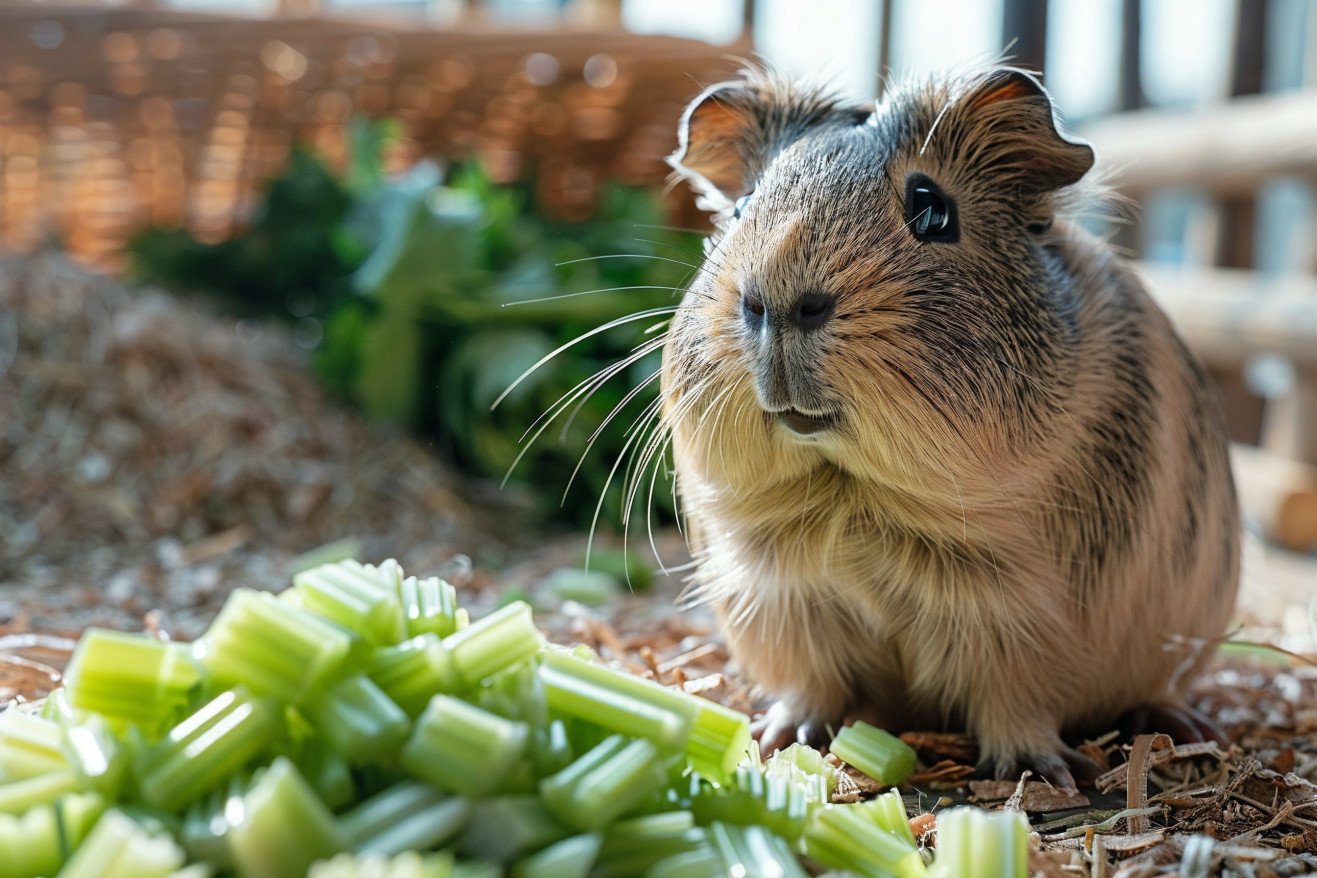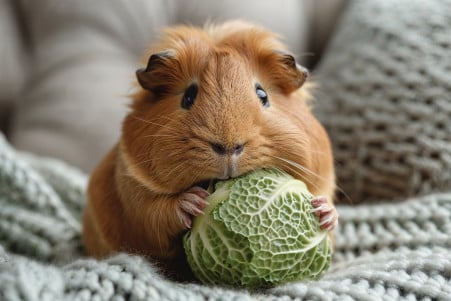Can Guinea Pigs Have Celery? Feeding Tips and Health Facts
2 March 2024 • Updated 1 March 2024

Celery is a popular food in many human diets, but its role in a guinea pig’s diet is a bit more complicated. Celery, including the leaves, is safe for guinea pigs to eat and can be part of a well-rounded diet. However, it should be fed in moderation, ideally 2–3 times a week, and cut into small pieces to avoid choking.
Overconsumption of celery can cause urinary issues in guinea pigs because it’s high in calcium and oxalates.
To offer a more comprehensive view of guinea pig dietary needs, we’ll be looking at studies from vets and animal experts. This will include research into the ideal diet for guinea pigs, the nutritional content of vegetables like celery, and the way these factors interact to support a guinea pig’s well-being.
By understanding how to responsibly add celery to your pet’s diet, you can feel confident in the choices you make about what to feed them.
Can guinea pigs have celery?
What Celery Does to a Guinea Pig’s Diet
Celery has a few different nutritional impacts on guinea pigs. First and foremost, it is a good source of important vitamins, including Vitamin C and Vitamin A. Both of these vitamins are essential for a guinea pig’s immune system, vision, and overall development.
In fact, guinea pigs require Vitamin C in their diet to avoid scurvy, which can lead to symptoms like lethargy, a rough coat, and weight loss. This is because guinea pigs cannot produce their own Vitamin C. According to GuineaDad, celery does contain Vitamin C, although other vegetables may have more.
Celery is also high in water, which can help keep guinea pigs hydrated, and it contains dietary fiber, which is important for a healthy gut. On the other hand, the mineral content in celery, especially calcium, can be problematic. PetsRadar notes that you should be careful about the calcium and oxalates in celery since too much can lead to urinary tract problems and kidney or bladder stones.
Because of this, it’s important to feed celery to guinea pigs in moderation, with 2–3 times a week being the recommended frequency.
You should also make sure to cut it into small, bite-sized pieces to avoid choking and to make it easier for your guinea pig to eat.
Finally, you can balance out the calcium in celery by feeding it with other vegetables that are lower in the mineral, like lettuce or bell peppers.
Vitamin C in Guinea Pig Diets
Like humans, guinea pigs cannot synthesize vitamin C and need to consume it in their diet to avoid scurvy, which can cause symptoms like lethargy, rough coat, and weight loss.
The Humane Society of the United States stresses the importance of including vitamin C–rich foods in guinea pigs’ daily diets to avoid these health problems. While celery can help with this, it’s lower in vitamin C than some other vegetables that guinea pigs love, like bell peppers and broccoli.
Historical information from NCBI Bookshelf shows that guinea pigs used to eat a wide variety of plants, some of which likely contained high levels of vitamin C.
A lack of this important vitamin can lead to serious health problems, including a weakened immune system and poor wound healing.
To make sure guinea pigs get enough vitamin C, the RSPCA says that guinea pigs should be fed fresh vegetables and leafy greens daily in addition to their main hay-based diet. This is important for guinea pigs’ overall health and longevity, just like keeping an eye on their oxalate consumption, which is also important for their health.
Oxalates and Their Impact on Guinea Pigs
Oxalates, or oxalic acid, are compounds found in many plants, including vegetables like celery, that bind to minerals in the body. Although they are a normal part of the diet, too many oxalates can be dangerous for guinea pigs. According to PetsRadar, celery is one of the vegetables with the highest levels of oxalates, which can lead to the formation of kidney and bladder stones and, in turn, urinary tract problems.
A case study published in PMC details how a guinea pig suffered from renal failure after eating the leaves of a plant that was high in oxalates, demonstrating just how serious the impact of high oxalate levels can be. This makes it especially important to make sure that your guinea pig’s oxalate intake is carefully controlled. This makes it especially important to make sure that your guinea pig’s oxalate intake is carefully controlled.
The Dodo explains that, according to Samantha Henson, a clinical pet nutritionist with Next Generation Pet Wellness, it’s best to feed oxalate-containing foods like celery in moderation. To reduce the risk of problems, it’s best to feed no more than a 2-inch piece of celery that’s been washed and is free of pesticides three times a week.
Feeding celery in conjunction with other low-oxalate vegetables can help ensure that your guinea pig stays healthy and doesn’t experience any urinary issues.
How to Manage Calcium Levels in Guinea Pig Diets
Calcium is important for guinea pigs to maintain strong bones and teeth, but too much can be harmful. ExoticDirect explains that excessive calcium intake can lead to the formation of bladder and kidney stones, which can be life-threatening for guinea pigs.
While celery is a good source of calcium, it’s important to remember that guinea pigs, unlike rabbits, can’t synthesize their own Vitamin C and need a low-calcium diet to avoid urinary tract problems, according to UK Pet Food.
To make sure that their guinea pigs are getting a well-rounded diet, pet owners can compare the calcium levels in celery to other vegetables. For example, leafy greens like kale and broccoli are high in Vitamin C and may have a more balanced calcium level for guinea pigs. ExoticDirect recommends that pet owners feed their guinea pigs a variety of vegetables to help prevent them from getting too much calcium.
By following the advice from UK Pet Food, pet owners can mix high-calcium foods like celery with low-calcium foods, keep an eye on serving sizes, and introduce new foods slowly.
It’s important to regularly evaluate the overall diet and maintain the proper calcium to phosphorus ratio to prevent the formation of phosphate stones. By taking these factors into account, pet owners can make sure that their guinea pigs’ diets support their health, don’t cause them harm, and include dietary fiber, another important part of their diet.
Fiber in a Guinea Pig’s Diet
Fiber is an often-overlooked part of a guinea pig’s diet, but it’s important for a number of reasons. Fiber is important for digestion and gut health, and a paper published in PMC shows that plant-derived dietary fiber is important for maintaining a healthy gut microbiota, which is important for digestion and nutrient absorption.
Guinea pigs are herbivores, so they need a high-fiber diet to keep their intestines moving and to prevent dental disease, which can be caused by their teeth not wearing down properly.
Celery, as a fibrous vegetable, can help with this part of a guinea pig’s diet. However, it’s important to consider the type and amount of fiber that it provides in comparison to other vegetables.
The best sources of fiber for guinea pigs are a mix of leafy greens, hay, and other vegetables that offer a mix of soluble and insoluble fiber. According to Veterinary Nursing of Exotic Pets, guinea pigs should be fed a high-fiber diet that includes a mix of vegetables, in addition to hay, to ensure that they get a good mix of nutrients.
If you want to add a mix of fiber-rich vegetables to your guinea pig’s diet, make sure to introduce new foods slowly. This will help you avoid digestive issues and make sure that your pet isn’t having a bad reaction to the new food. Also, while celery can be helpful, it’s important to make sure that it’s just one part of a mix of fibrous foods that you’re feeding your guinea pig.
Conclusion: Can Guinea Pigs Eat Celery?
It is important for pet parents to understand the pros and cons of feeding celery to guinea pigs. Celery is full of vitamins and fiber, which can help your guinea pig stay healthy if it is fed in moderation.
However, this means following the guidelines that have been laid out—feed your guinea pig small amounts of celery a few times a week to ensure they get the benefits of variety without overloading them with calcium and oxalates.
It is also important to remember the importance of a balanced diet. A diet that is high in vitamin C and low in calcium is essential for preventing scurvy and urinary tract problems.
It is up to all of us to make sure our guinea pigs are healthy by feeding them a well-rounded diet. Armed with this information, you can feel good about feeding your guinea pig celery as part of a healthy, well-rounded diet that will help them live a long, happy life.


